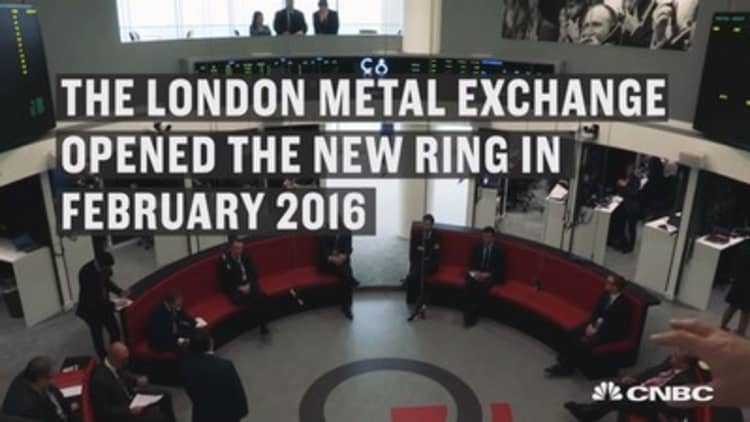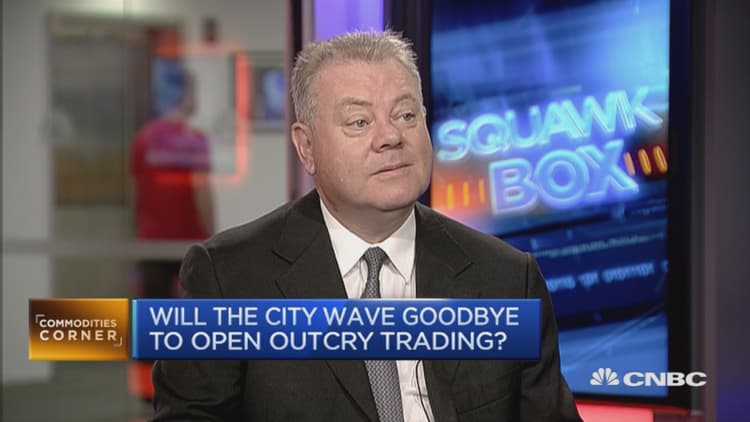In a small room to the side of the trading "ring" of the London Metals Exchange, two young traders take a quick 10 minutes from their hectic days to play their favorite board game. The game of choice is backgammon, one of the world's oldest games, and the two gleefully play it on an upturned box.
As quickly as it's started, the game is cleared away and the two men head at back to work. The bell rings and the trading pit echoes to shouts and bellows of offers and counter-offers.
Like the centuries-old board game, the London Metal Exchange (LME) harks back to a different time. It's the last bastion of a trading system that evokes memories of Victorian London.

It's now the only financial exchange in Europe to maintain open outcry trading. First established in 1877, ownership of the exchange was shared among its members before its acquisition in 2012. It is now owned by a Hong Kong-based company, but has held on to its trading pit despite the trend towards all-electronic operations - and moved to a new location in Finsbury Square, London earlier this year.
"Moving here we decided it was absolutely right to build a new ring. It's what the market wants, it's what our customers want, it's what we wanted. So we're very pleased to have it here," Stuart Sloan, the chief operating officer and head of strategy at the LME, told CNBC.
The new ring keeps its traditional circle of padded red-leather seats. Traders are mostly male, all suited with ties and top buttons fastened as part of strict dress code. Arcane hand signals are still used during short bursts of intense and "highly liquid" five-minute sessions.

Complex date structures
The pit trades metal futures in commodities like copper and aluminum. A futures contract is a financial instrument that gives a client the obligation to buy or sell a standard quantity of a specified asset on a set date, at a fixed price agreed at the point of sale. Many still regard open outcry as useful for trading these complex date structures, as well as setting crucial prices that are used by firms like miners and smelters, and consumers, to negotiate physical deals.
There are currently nine member companies that trade in the ring and pay the $95,000 annual fee, according to the LME website. Volumes in the ring account for roughly 12 percent of total volume at the exchange's business. The notional value of total contracts traded last year at the exchange was around $12 trillion, thus the value of ring-traded volume last year was roughly $18.7 billion.
"The thing that really works about the ring, is it is the place we set the reference prices. It's where all of the buying and selling interest comes together ... for the prices to be set for all of those base metals .. and that seems to work better than other methods." Sloan said.
He added that open outcry wouldn't necessarily set a more accurate price for a commodity but it's benefit would be its ability to "manage the complex price curve."
"We trade multiple dates, it's not just the price of today. It's going out - in the case of copper and aluminum - 10 years. You have set prices all along that curve and human beings interacting face-to-face are very good at managing that complexity," he said.
However, there's an "ebb and flow of participants" at the ring, according to Sloan. JPMorgan, for example, last year decided to relinquish its membership and opt for a category two subscription which just utilizes electronic and telephone trading. Nonetheless, Sloan told CNBC that overall LME membership has been growing.

US closures
Across the Atlantic Ocean, the days of open outcry are very much numbered. The CME Group closed most of its futures trading pits in Chicago and New York City last year. The reason was that open outcry futures trading had fallen to just 1 percent of the company's total futures volume.
CME is now planning to completely close its New York trading floor at the end of 2016 as it currently represents just 0.3 percent of the company's overall energy and metals trading volumes. It's instead making space available for floor traders to transition to electronic trading at the company's One North End Avenue facility in Battery Park. It's Chicago trading floor is set to remain open for the trading of options on futures contracts, as well as S&P 500 futures contracts.
A look at the historical prices for a seat on U.S. trading floors also tells its own story. An individual membership for the NYMEX is currently priced at around $200,000 for the year. In 1998, that was more like $700,000 and in 2005 that was more like $3 million. A report by the Financial Times earlier this year stated that the number of people employed in New York City jobs who trade in securities and commodities contracts had fallen below 100,000 from around 150,000 at the turn of the century.
The death knell?
Many point to the City of London's "Big Bang" in 1986 as the beginning of the end. This was the de-regulation of the securities industry and trading at the London Stock Exchange moved from face-to-face dealings on the market floor to computer and telephone dealings.
The LSE underlines that this new method was a solution for distributing information "fairly and widely." But in a period when City traders are still being prosecuted for manipulating the foreign exchange markets and key rates such as Libor (London interbank offered rate), many traders lament the days of open outcry and speak of some advantages that the older system had.
Neil Crammond has 30 years of financial futures experience at places including the former trading floor at the London International Financial Futures and Options Exchange (LIFFE, pronounced 'life'). He believes that one of the advantages of open outcry was its real-time regulation.
"There were not just pit officials watching the market prices but also an elected team of pit committees and floor committees on hand during the trading day," he told CNBC via social media.
"Any disputed price trade etc was instantly dealt with and the market carried on in a fair and orderly way ... The issue with (screen-based trading) for years was simply that the market supervision department was not respected."
"Brash, loud and colorful and that was just the trading jackets. Liffe (the London International Financial Futures Exchange) was quite simply the best place to be for any young man or woman, though it was primarily men, in the 1990s.
Sure there were more stable parts of the City of London to build a career, from the stuffy formality of Lloyd’s of London to the bewigged inhabitants of the law courts but if it was money, adrenaline and banter that you were looking for nothing in the City compared.
I joined the London Trading Options Market (LTOM) back in 1988 a couple of years before its merger with Liffe. Back then LTOM still inhabited the ghostly London Stock Exchange (LSE) floor that had up until 1986 and the “Big Bang” been the hub of equity trading in London. Even though LTOM took up only a fraction of the LSE's huge hexagon-covered floor there was still a tremendous buzz about the place.
If you were a shrinking wallflower then you could walk straight back out the door on a career on the floor, but if you loved cut-throat aggression, had quick numeracy and could stand up for yourself in a confrontation, then this was not only a highly lucrative job but was also a lot of fun.
It was when LTOM joined with Liffe in the early 1990s though that things got a lot bigger. Down at our brand new site on Cannon Street thousands of dealers, brokers and back-up staff all donned the famous garish jackets (red of course being the color for the locals who used at least a portion of their own money in the pits) and went about the raucous business of the futures and options market.
One myth is that it was full of just a bunch of Essex barrow-boys. In truth there were quite a few barrow-boys from Kent and Middlesex too but there was also a healthy contingent of Americans, usually out of New York or Chicago who'd come over to London to try their hand. Plus a lot of very smart, university educated traders were also dotted about the floor, writing financial models (adaptations of the Black-Scholes mathematical model and the like) trying to find an edge. It was a broad church.
Was Liffe a hard, aggressive place to work? Yes. Was it full of flash, brash and extremely highly paid twenty-something year olds? Yes. But for most of us down in the pits it was the time of our lives."

Crammond adds that it was only until last month and the introduction of Market Abuse Regulation, new legislation that aims to increase integrity and protection, "that we are finally getting back to proper supervision."
Others would disagree and suggest computers have been trained for more in-depth regulation and provide much more transparency.
"In the pit, two people monitored disputes which was an amazingly inefficient system. The advantages for open outcry just aren't there anymore," Keith Pilbeam, author and economics professor at London's City University, told CNBC via telephone.

Pilbeam states that computers are now giving traders "better and quicker verification of trades" and allow people to simply trade from their own home. "The world has changed. Stock trading has changed," he said. "(Only) people with vested interests want to keep it going."
If the radical change in other sectors are any indication, then it won't be long before computers completely take over from the manual system of trading. But for now, this small corner of London is perfectly happy and rather proud with its traditions and idiosyncrasies.
"Whilst our customers in the market want to use it, we're going to support it," the LME's Sloan told CNBC.
Credits:
Reporting: Matt Clinch
Video: Jonathan Cronin
Images: CNBC, Getty Images


